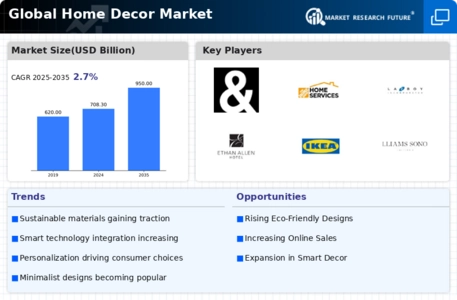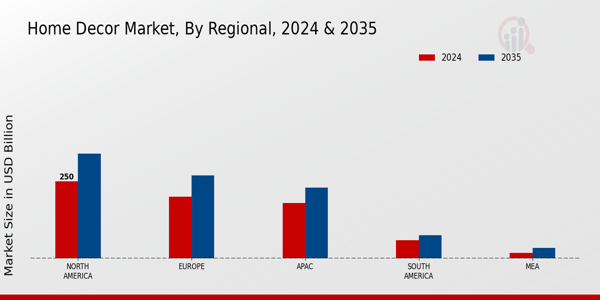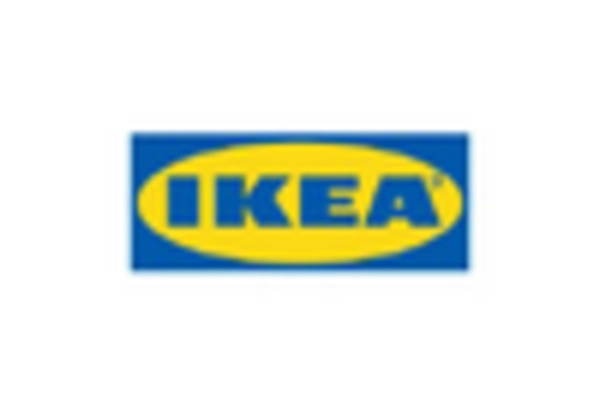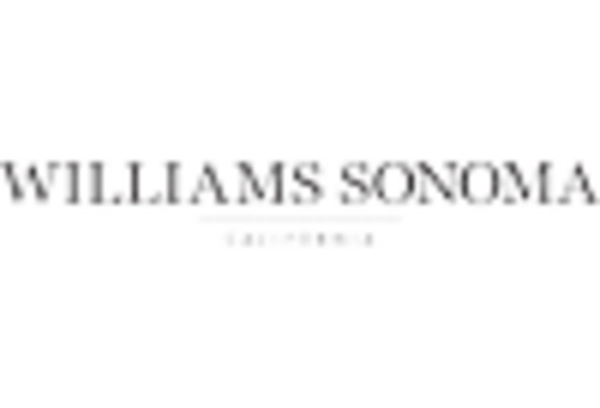- Home Decor Market By Product Type (USD Billion, 2019-2035)
- Furniture
- Textiles
- Wall Decor
- Tableware
- Lighting
- Home Decor Market By Material (USD Billion, 2019-2035)
- Wood
- Metal
- Glass
- Plastic
- Ceramic
- Home Decor Market By Style (USD Billion, 2019-2035)
- Modern
- Traditional
- Vintage
- Industrial
- Bohemian
- Home Decor Market By Distribution Channel (USD Billion, 2019-2035)
- Online Retail
- Specialty Stores
- Department Stores
- Home Improvement Stores
- Home Decor Market By Regional (USD Billion, 2019-2035)
- North America
- Europe
- South America
- Asia Pacific
- Middle East and Africa
North America Outlook (USD Billion, 2019-2035)
North America Home Decor Market by Product Type
Furniture
Textiles
Wall Decor
Tableware
Lighting
North America Home Decor Market by Material Type
Wood
Metal
Glass
Plastic
Ceramic
North America Home Decor Market by Style Type
Modern
Traditional
Vintage
Industrial
Bohemian
North America Home Decor Market by Distribution Channel Type
Online Retail
Specialty Stores
Department Stores
Home Improvement Stores
North America Home Decor Market by Regional Type
US
Canada
US Outlook (USD Billion, 2019-2035)
US Home Decor Market by Product Type
Furniture
Textiles
Wall Decor
Tableware
Lighting
US Home Decor Market by Material Type
Wood
Metal
Glass
Plastic
Ceramic
US Home Decor Market by Style Type
Modern
Traditional
Vintage
Industrial
Bohemian
US Home Decor Market by Distribution Channel Type
Online Retail
Specialty Stores
Department Stores
Home Improvement Stores
CANADA Outlook (USD Billion, 2019-2035)
CANADA Home Decor Market by Product Type
Furniture
Textiles
Wall Decor
Tableware
Lighting
CANADA Home Decor Market by Material Type
Wood
Metal
Glass
Plastic
Ceramic
CANADA Home Decor Market by Style Type
Modern
Traditional
Vintage
Industrial
Bohemian
CANADA Home Decor Market by Distribution Channel Type
Online Retail
Specialty Stores
Department Stores
Home Improvement Stores
Europe Outlook (USD Billion, 2019-2035)
Europe Home Decor Market by Product Type
Furniture
Textiles
Wall Decor
Tableware
Lighting
Europe Home Decor Market by Material Type
Wood
Metal
Glass
Plastic
Ceramic
Europe Home Decor Market by Style Type
Modern
Traditional
Vintage
Industrial
Bohemian
Europe Home Decor Market by Distribution Channel Type
Online Retail
Specialty Stores
Department Stores
Home Improvement Stores
Europe Home Decor Market by Regional Type
Germany
UK
France
Russia
Italy
Spain
Rest of Europe
GERMANY Outlook (USD Billion, 2019-2035)
GERMANY Home Decor Market by Product Type
Furniture
Textiles
Wall Decor
Tableware
Lighting
GERMANY Home Decor Market by Material Type
Wood
Metal
Glass
Plastic
Ceramic
GERMANY Home Decor Market by Style Type
Modern
Traditional
Vintage
Industrial
Bohemian
GERMANY Home Decor Market by Distribution Channel Type
Online Retail
Specialty Stores
Department Stores
Home Improvement Stores
UK Outlook (USD Billion, 2019-2035)
UK Home Decor Market by Product Type
Furniture
Textiles
Wall Decor
Tableware
Lighting
UK Home Decor Market by Material Type
Wood
Metal
Glass
Plastic
Ceramic
UK Home Decor Market by Style Type
Modern
Traditional
Vintage
Industrial
Bohemian
UK Home Decor Market by Distribution Channel Type
Online Retail
Specialty Stores
Department Stores
Home Improvement Stores
FRANCE Outlook (USD Billion, 2019-2035)
FRANCE Home Decor Market by Product Type
Furniture
Textiles
Wall Decor
Tableware
Lighting
FRANCE Home Decor Market by Material Type
Wood
Metal
Glass
Plastic
Ceramic
FRANCE Home Decor Market by Style Type
Modern
Traditional
Vintage
Industrial
Bohemian
FRANCE Home Decor Market by Distribution Channel Type
Online Retail
Specialty Stores
Department Stores
Home Improvement Stores
RUSSIA Outlook (USD Billion, 2019-2035)
RUSSIA Home Decor Market by Product Type
Furniture
Textiles
Wall Decor
Tableware
Lighting
RUSSIA Home Decor Market by Material Type
Wood
Metal
Glass
Plastic
Ceramic
RUSSIA Home Decor Market by Style Type
Modern
Traditional
Vintage
Industrial
Bohemian
RUSSIA Home Decor Market by Distribution Channel Type
Online Retail
Specialty Stores
Department Stores
Home Improvement Stores
ITALY Outlook (USD Billion, 2019-2035)
ITALY Home Decor Market by Product Type
Furniture
Textiles
Wall Decor
Tableware
Lighting
ITALY Home Decor Market by Material Type
Wood
Metal
Glass
Plastic
Ceramic
ITALY Home Decor Market by Style Type
Modern
Traditional
Vintage
Industrial
Bohemian
ITALY Home Decor Market by Distribution Channel Type
Online Retail
Specialty Stores
Department Stores
Home Improvement Stores
SPAIN Outlook (USD Billion, 2019-2035)
SPAIN Home Decor Market by Product Type
Furniture
Textiles
Wall Decor
Tableware
Lighting
SPAIN Home Decor Market by Material Type
Wood
Metal
Glass
Plastic
Ceramic
SPAIN Home Decor Market by Style Type
Modern
Traditional
Vintage
Industrial
Bohemian
SPAIN Home Decor Market by Distribution Channel Type
Online Retail
Specialty Stores
Department Stores
Home Improvement Stores
REST OF EUROPE Outlook (USD Billion, 2019-2035)
REST OF EUROPE Home Decor Market by Product Type
Furniture
Textiles
Wall Decor
Tableware
Lighting
REST OF EUROPE Home Decor Market by Material Type
Wood
Metal
Glass
Plastic
Ceramic
REST OF EUROPE Home Decor Market by Style Type
Modern
Traditional
Vintage
Industrial
Bohemian
REST OF EUROPE Home Decor Market by Distribution Channel Type
Online Retail
Specialty Stores
Department Stores
Home Improvement Stores
APAC Outlook (USD Billion, 2019-2035)
APAC Home Decor Market by Product Type
Furniture
Textiles
Wall Decor
Tableware
Lighting
APAC Home Decor Market by Material Type
Wood
Metal
Glass
Plastic
Ceramic
APAC Home Decor Market by Style Type
Modern
Traditional
Vintage
Industrial
Bohemian
APAC Home Decor Market by Distribution Channel Type
Online Retail
Specialty Stores
Department Stores
Home Improvement Stores
APAC Home Decor Market by Regional Type
China
India
Japan
South Korea
Malaysia
Thailand
Indonesia
Rest of APAC
CHINA Outlook (USD Billion, 2019-2035)
CHINA Home Decor Market by Product Type
Furniture
Textiles
Wall Decor
Tableware
Lighting
CHINA Home Decor Market by Material Type
Wood
Metal
Glass
Plastic
Ceramic
CHINA Home Decor Market by Style Type
Modern
Traditional
Vintage
Industrial
Bohemian
CHINA Home Decor Market by Distribution Channel Type
Online Retail
Specialty Stores
Department Stores
Home Improvement Stores
INDIA Outlook (USD Billion, 2019-2035)
INDIA Home Decor Market by Product Type
Furniture
Textiles
Wall Decor
Tableware
Lighting
INDIA Home Decor Market by Material Type
Wood
Metal
Glass
Plastic
Ceramic
INDIA Home Decor Market by Style Type
Modern
Traditional
Vintage
Industrial
Bohemian
INDIA Home Decor Market by Distribution Channel Type
Online Retail
Specialty Stores
Department Stores
Home Improvement Stores
JAPAN Outlook (USD Billion, 2019-2035)
JAPAN Home Decor Market by Product Type
Furniture
Textiles
Wall Decor
Tableware
Lighting
JAPAN Home Decor Market by Material Type
Wood
Metal
Glass
Plastic
Ceramic
JAPAN Home Decor Market by Style Type
Modern
Traditional
Vintage
Industrial
Bohemian
JAPAN Home Decor Market by Distribution Channel Type
Online Retail
Specialty Stores
Department Stores
Home Improvement Stores
SOUTH KOREA Outlook (USD Billion, 2019-2035)
SOUTH KOREA Home Decor Market by Product Type
Furniture
Textiles
Wall Decor
Tableware
Lighting
SOUTH KOREA Home Decor Market by Material Type
Wood
Metal
Glass
Plastic
Ceramic
SOUTH KOREA Home Decor Market by Style Type
Modern
Traditional
Vintage
Industrial
Bohemian
SOUTH KOREA Home Decor Market by Distribution Channel Type
Online Retail
Specialty Stores
Department Stores
Home Improvement Stores
MALAYSIA Outlook (USD Billion, 2019-2035)
MALAYSIA Home Decor Market by Product Type
Furniture
Textiles
Wall Decor
Tableware
Lighting
MALAYSIA Home Decor Market by Material Type
Wood
Metal
Glass
Plastic
Ceramic
MALAYSIA Home Decor Market by Style Type
Modern
Traditional
Vintage
Industrial
Bohemian
MALAYSIA Home Decor Market by Distribution Channel Type
Online Retail
Specialty Stores
Department Stores
Home Improvement Stores
THAILAND Outlook (USD Billion, 2019-2035)
THAILAND Home Decor Market by Product Type
Furniture
Textiles
Wall Decor
Tableware
Lighting
THAILAND Home Decor Market by Material Type
Wood
Metal
Glass
Plastic
Ceramic
THAILAND Home Decor Market by Style Type
Modern
Traditional
Vintage
Industrial
Bohemian
THAILAND Home Decor Market by Distribution Channel Type
Online Retail
Specialty Stores
Department Stores
Home Improvement Stores
INDONESIA Outlook (USD Billion, 2019-2035)
INDONESIA Home Decor Market by Product Type
Furniture
Textiles
Wall Decor
Tableware
Lighting
INDONESIA Home Decor Market by Material Type
Wood
Metal
Glass
Plastic
Ceramic
INDONESIA Home Decor Market by Style Type
Modern
Traditional
Vintage
Industrial
Bohemian
INDONESIA Home Decor Market by Distribution Channel Type
Online Retail
Specialty Stores
Department Stores
Home Improvement Stores
REST OF APAC Outlook (USD Billion, 2019-2035)
REST OF APAC Home Decor Market by Product Type
Furniture
Textiles
Wall Decor
Tableware
Lighting
REST OF APAC Home Decor Market by Material Type
Wood
Metal
Glass
Plastic
Ceramic
REST OF APAC Home Decor Market by Style Type
Modern
Traditional
Vintage
Industrial
Bohemian
REST OF APAC Home Decor Market by Distribution Channel Type
Online Retail
Specialty Stores
Department Stores
Home Improvement Stores
South America Outlook (USD Billion, 2019-2035)
South America Home Decor Market by Product Type
Furniture
Textiles
Wall Decor
Tableware
Lighting
South America Home Decor Market by Material Type
Wood
Metal
Glass
Plastic
Ceramic
South America Home Decor Market by Style Type
Modern
Traditional
Vintage
Industrial
Bohemian
South America Home Decor Market by Distribution Channel Type
Online Retail
Specialty Stores
Department Stores
Home Improvement Stores
South America Home Decor Market by Regional Type
Brazil
Mexico
Argentina
Rest of South America
BRAZIL Outlook (USD Billion, 2019-2035)
BRAZIL Home Decor Market by Product Type
Furniture
Textiles
Wall Decor
Tableware
Lighting
BRAZIL Home Decor Market by Material Type
Wood
Metal
Glass
Plastic
Ceramic
BRAZIL Home Decor Market by Style Type
Modern
Traditional
Vintage
Industrial
Bohemian
BRAZIL Home Decor Market by Distribution Channel Type
Online Retail
Specialty Stores
Department Stores
Home Improvement Stores
MEXICO Outlook (USD Billion, 2019-2035)
MEXICO Home Decor Market by Product Type
Furniture
Textiles
Wall Decor
Tableware
Lighting
MEXICO Home Decor Market by Material Type
Wood
Metal
Glass
Plastic
Ceramic
MEXICO Home Decor Market by Style Type
Modern
Traditional
Vintage
Industrial
Bohemian
MEXICO Home Decor Market by Distribution Channel Type
Online Retail
Specialty Stores
Department Stores
Home Improvement Stores
ARGENTINA Outlook (USD Billion, 2019-2035)
ARGENTINA Home Decor Market by Product Type
Furniture
Textiles
Wall Decor
Tableware
Lighting
ARGENTINA Home Decor Market by Material Type
Wood
Metal
Glass
Plastic
Ceramic
ARGENTINA Home Decor Market by Style Type
Modern
Traditional
Vintage
Industrial
Bohemian
ARGENTINA Home Decor Market by Distribution Channel Type
Online Retail
Specialty Stores
Department Stores
Home Improvement Stores
REST OF SOUTH AMERICA Outlook (USD Billion, 2019-2035)
REST OF SOUTH AMERICA Home Decor Market by Product Type
Furniture
Textiles
Wall Decor
Tableware
Lighting
REST OF SOUTH AMERICA Home Decor Market by Material Type
Wood
Metal
Glass
Plastic
Ceramic
REST OF SOUTH AMERICA Home Decor Market by Style Type
Modern
Traditional
Vintage
Industrial
Bohemian
REST OF SOUTH AMERICA Home Decor Market by Distribution Channel Type
Online Retail
Specialty Stores
Department Stores
Home Improvement Stores
MEA Outlook (USD Billion, 2019-2035)
MEA Home Decor Market by Product Type
Furniture
Textiles
Wall Decor
Tableware
Lighting
MEA Home Decor Market by Material Type
Wood
Metal
Glass
Plastic
Ceramic
MEA Home Decor Market by Style Type
Modern
Traditional
Vintage
Industrial
Bohemian
MEA Home Decor Market by Distribution Channel Type
Online Retail
Specialty Stores
Department Stores
Home Improvement Stores
MEA Home Decor Market by Regional Type
GCC Countries
South Africa
Rest of MEA
GCC COUNTRIES Outlook (USD Billion, 2019-2035)
GCC COUNTRIES Home Decor Market by Product Type
Furniture
Textiles
Wall Decor
Tableware
Lighting
GCC COUNTRIES Home Decor Market by Material Type
Wood
Metal
Glass
Plastic
Ceramic
GCC COUNTRIES Home Decor Market by Style Type
Modern
Traditional
Vintage
Industrial
Bohemian
GCC COUNTRIES Home Decor Market by Distribution Channel Type
Online Retail
Specialty Stores
Department Stores
Home Improvement Stores
SOUTH AFRICA Outlook (USD Billion, 2019-2035)
SOUTH AFRICA Home Decor Market by Product Type
Furniture
Textiles
Wall Decor
Tableware
Lighting
SOUTH AFRICA Home Decor Market by Material Type
Wood
Metal
Glass
Plastic
Ceramic
SOUTH AFRICA Home Decor Market by Style Type
Modern
Traditional
Vintage
Industrial
Bohemian
SOUTH AFRICA Home Decor Market by Distribution Channel Type
Online Retail
Specialty Stores
Department Stores
Home Improvement Stores
REST OF MEA Outlook (USD Billion, 2019-2035)
REST OF MEA Home Decor Market by Product Type
Furniture
Textiles
Wall Decor
Tableware
Lighting
REST OF MEA Home Decor Market by Material Type
Wood
Metal
Glass
Plastic
Ceramic
REST OF MEA Home Decor Market by Style Type
Modern
Traditional
Vintage
Industrial
Bohemian
REST OF MEA Home Decor Market by Distribution Channel Type
Online Retail
Specialty Stores
Department Stores
Home Improvement Stores


















Leave a Comment